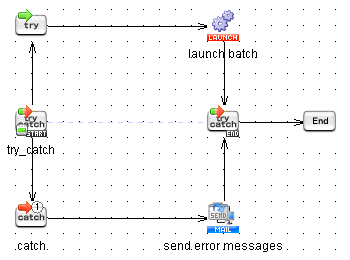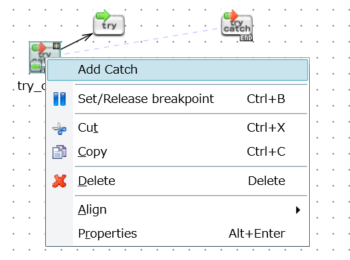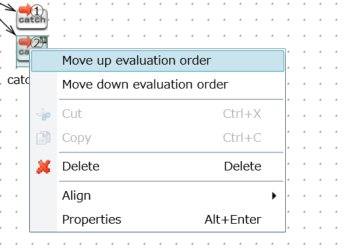Monitor Exception
Operation name
Monitor Exception
Function overview
Monitors and handles exceptions for target operations.
Monitor Exception configuration
|
Icon |
Name |
Description |
|---|---|---|

|
Start Monitor Exception |
The start of Monitor Exception. |

|
Try |
Place components to monitor for exceptions between Try and End Monitor Exception. |

|
Catch |
Place components to be used when handling an exception thrown in the target operation, between Catch and End Monitor Exception. |

|
End Monitor Exception |
The end of Monitor Exception. |
Properties
For details on use of variables, refer to Variables.
Basic settings
|
Item name |
Required/Optional |
Use of variables |
Description |
Remarks |
|---|---|---|---|---|
|
Name |
Required |
Not available |
Enter a name to use on the script canvas. |
|
Required settings
|
Item name |
Required/Optional |
Use of variables |
Description |
Remarks |
|---|---|---|---|---|
|
Target |
Required |
Not available |
Select a component to monitor for exceptions. When an exception is raised while processing the selected component, exception handling is performed for Catch. |
|
Comment
|
Item name |
Required/Optional |
Use of variables |
Description |
Remarks |
|---|---|---|---|---|
|
Comment |
Optional |
Not available |
You can write a short description of this connector. |
|
Icon-click menu
|
Icon |
Item name |
Description |
Remarks |
|---|---|---|---|

|
Fold/Expand |
Select + or - displayed on the icon. Show/hide icons between Start Monitor Exception and End Monitor Exception. When folded, only Start Monitor Exception is displayed. |
|
Right-click menu
|
Icon |
Item name |
Description |
Remarks |
|---|---|---|---|

|
Add Catch |
Add a Catch icon. |
|

|
Move up evaluation order |
Move the order of the selected Catch upwards by one. |
|

|
Move down evaluation order |
Move the order of the selected Catch downwards by one. |
|
Parallel Stream Processing
PSP isn't supported.
Available component variables
|
Component variable name |
Description |
Remarks |
|---|---|---|
|
component_name |
When an error occurs in a monitored component, the component name is stored. |
|
|
component_type |
When an error occurs in a monitored component, the component type is stored. |
|
|
message_category |
When an error occurs in a monitored component, the category of the message code corresponding to the error is stored. |
|
|
message_code |
When an error occurs in a monitored component, the message code corresponding to the error is stored. |
|
|
message_level |
When an error occurs in a monitored component, the severity of the message code corresponding to the error is stored. |
|
|
error_type |
When an error occurs in a monitored component, the error type is stored. |
|
|
error_message |
When an error occurs in a monitored component, the error message is stored. |
|
|
error_trace |
When an error occurs in a monitored component, the trace information of the error is stored. |
|
How to operate Monitor Exception
Creation of Monitor Exception
Place components to be monitored between Try and End Monitor Exception.

Addition of Catch
Select Add Catch from the right-click menu of Start Monitor Exception and add a Catch operation.
The maximum number of Catch icons that can be added is 98.

Change of the evaluation order of Catch operations
Select Move up evaluation order or Move down evaluation order from the right-click menu of Catch to change the evaluation order of multiple Catch operations.
The number encircled on Catch is the evaluation order.

-
Script compilation fails if the Raise Exception operation is placed between the Try icon and the End Monitor Exception icon.
Exception messages
None.
Notes
-
The properties windows for Start Monitor Exception, Try, and End Monitor Exception can't be opened.
-
Script transactions are rolled back only when the script is terminated unsuccessfully. In other words, when executing the script involved in the transaction, even if the processing fails in an operation component, if that operation is a monitoring target for the Monitor Exception operation, then that exception will be detected and the script won't be terminated unsuccessfully. The transaction is committed.
For more details on the Transaction operation (Transaction component), refer to Notes.